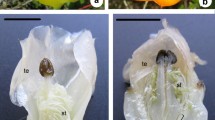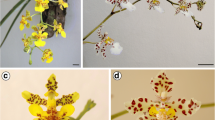Abstract
Floral nectaries have contributed to the systematics of different taxonomic groups. Since those of the neotropical genera included in subfamily Salacioideae—Cheiloclinium Miers, Peritassa Miers, Salacia L. and Tontelea Aubl.—have different forms and positions, we explored their anatomy to delimit more precisely the genera of subfamily Salacioideae. Buds and open flowers of six species were treated following the usual techniques in plant anatomy. The obtained data were helpful in characterizing the floral nectary anatomy of the studied species. Furthermore, some features such as form, position and surface of nectaries; form of their epidermal cells; presence and distribution of stomata; occurrence of idioblasts containing druses in the nectariferous parenchyma; and absence of nectary vascularization can contribute to the taxonomy and phylogeny of the Salacioideae studied. In most of the studied species the nectar is probably released by both the stomata and the nectary epidermal surface. In Cheiloclinium cognatum, the structure acknowledged as nectary is actually a vestigial tissue and the functions of attracting and rewarding pollinators has phylogenetically migrated to the stigmatic region. The druses and phenolic substances observed in the nectariferous parenchyma probably help defend flowers against herbivore attacks. The minute size of the nectaries of Salacioideae may explain the absence of vascularization. The floral nectaries of Salacia elliptica are epithelial while those of the other species are mesenchymal.









Similar content being viewed by others
References
Ancibor E (1969) Los nectarios florales en Leguminosas-Mimosóideas. Darwiniana 15:128–142
Bentley B, Elias T (1983) The biology of nectaries. Columbia University Press, New York
Bernardello G (2007) A systematic survey of floral nectaries. In: Nicolson SW, Nepi M, Pacini E (eds) Nectaries and nectar. Springer, Dordrecht, pp 19–128
Castro MM, Machado SR (2003) Células e tecidos secretores. In: Appezzato-da-Glória B, Carmello-Guerreiro SM (eds) Anatomia vegetal. Editora UFV—Universidade Federal de Viçosa, Viçosa, pp 179–203
Coughenour JM, Simmons MP, Lombardi JA, Cappa JJ (2010) Phylogeny of Celastraceae subfamily Salacioideae and tribe Lophopetaleae inferred from morphological characters and nuclear and plastid genes. Syst Bot 35:358–367
Coughenour JM, Simmons MP, Lombardi JA, Yakobson K, Archer RH (2011) Phylogeny of Celastraceae subfamily Hippocrateoideae inferred from morphological characters and nuclear and plastid loci. Mol Phylogenet Evol 59:320–330. doi:10.1016/j.ympev.2011.02.017
Davies KL, Stpiczynska M, Gregg A (2005) Nectar-secreting floral stomata in Maxillaria anceps Ames & C. Schweinf. (Orchidaceae). Ann Bot 96:217–227. doi:10.1093/aob/mci182
Davis AR, Peterson RL, Shuel RW (1986) Anatomy and vasculature of the floral nectaries of Brassica napus (Brassicaceae). Can J Bot 64:2508–2516. doi:10.1139/b86-333
Den Hartog RM, Tholen V, Baas P (1978) Epidermal characters of the Celastraceae sensu lato. Acta Bot Neerl 27:355–388
Endress PK (1994) Diversity and evolutionary biology of tropical flowers. Cambridge University Press, Cambridge
Esau K (1977) Anatomy of seed plants, 2nd edn. Wiley, New York
Escalante-Pérez M, Heil M (2012) Nectar secretion: its ecological context and physiological regulation. In: Vivanco JM, Baluska F (eds) Secretions and exudates in biological systems, signaling and communication in plants 12. Springer, Berlin, pp 187–220. doi:10.1007/978-3-642-23047-9_9
Fahn A (1952) On the structure of floral nectaries. Bot Gaz 113:464–470. doi:10.1086/335735
Fahn A (1953) The topography of the nectary in the flower and its phylogenetical trend. Phytomorphology 3:424–426
Fahn A (1979a) Ultrastructure of nectaries in relation to nectar secretion. Am J Bot 66:977–985. doi:10.2307/2442240
Fahn A (1979b) Secretory tissues in plants. Academic Press, London
Fernandez MGV, Morales JB, Angeles G (1998) Anatomical studies on Hippocratea excelsa (Hippocrateaceae). Acta Bot Mex 43:7–21
Gaffal KP, Heimler W, El-Gamal S (1998) The floral nectary of Digitalis purpurea L., structure and nectar secretion. Ann Bot 81:251–262. doi:10.1006/anbo.1997.0546
Galetto L (1997) Flower structure and nectar chemical composition in three Argentine Apocynaceae. Flora 192:197–207. doi:10.1007/BF02506798
Galetto L, Bernardello G (2004) Floral nectaries, nectar production dynamics and chemical composition in six Ipomoea species (Convolvulaceae) in relation to pollinators. Ann Bot 94:269–280. doi:10.1093/aob/mch137
Gomes SMA, Lombardi J (2010) Leaf anatomy as a contribution to the taxonomy of Salacioideae N. Hallé ex Thorne & Reveal (Celastraceae). Plant Syst Evol 289:13–33. doi:10.1007/s00606-010-0328-8
Gomes SMA, Silva EAM, Lombardi JA, Azevedo AA, Vale FHA (2005) Anatomia foliar como subsídio à taxonomia de Hippocrateoideae (Celastraceae) no sudeste do Brasil. Acta Bot Bras 19:945–961. doi:10.1590/S0102-33062005000400029
Görts-van Rijn ARA, Mennega AMW (1994) Hippocrateaceae. In: Görts-van Rijn ARA (ed) Flora of the Guianas 16. Koeltz Scientific Books, Germany, pp 110–128
Johansen DA (1940) Plant microtechnique. McGraw Hill Book, New York
Kearns CA, Inouye DW (1993) Techniques for pollination biologists. University Press of Colorado, Niwot
Kraus JE, Arduin M (1997) Manual básico de métodos em morfologia vegetal. Universidade Federal Rural do Rio de Janeiro, Rio de Janeiro
Matthews ML, Endress PK (2005) Comparative floral structure and systematics in Celastrales (Celastraceae, Parnassiaceae, Lepidobotryaceae). Bot J Linn Soc 149:129–194
Mennega AMW (1983) Notes on new world Hippocrateae (Fam. Celastraceae) II- A new species in Hemiangium. Acta Bot Neerl 32:427–430
Mennega AMW (1997) Wood anatomy of the Hippocrateoideae (Celastraceae). IAWAJ 18:331–368
Metcalfe CR, Chalk L (1979) Anatomy of the dicotyledons: systematic anatomy of the leaf and stem, vol 1. Oxford University Press, New York
Metcalfe CR, Chalk L (1983) Anatomy of the dicotyledons: wood structure and conclusion of the general introduction v. 2. Oxford University Press, New York. doi:10.1016/0307-4412(83)90108-5
Nicolson SW, Nepi M, Pacini E (eds) (2007) Nectaries and nectar. Springer, Dordrecht
Paccini E, Nepi M, Vesprini JL (2003) Nectar biodiversity: a short review. Plant Syst Evol 238:7–21
Simmons MP (2004) Celastraceae. In: Kubitzki K (ed) The families and genera of vascular plants 6. Springer, Berlin, pp 29–64
Simmons MP, Savolainen V, Clevinger CC, Archer RH, Davis JI (2001) Phylogeny of the Celastraceae inferred from 26S nuclear ribosomal DNA, phytochrome B, rbcl, atpB, and morphology. Mol Phylogenet Evol 19:353–366. doi:10.1006/mpev.2001.0937
Smets E (1986) Localization and systematic importance of the floral nectaries in the Magnoliatae (Dicotyledons). Bull Jard Bot Nat Belg 56:51–76. doi:10.2307/3667757
Smith AC (1940) The American species of Hippocrateaceae. Brittonia 3:341–555
Smith LB, Robinson HE (1971) Hippocrateáceas. In: Reitz R (ed) Flora ilustrada catarinense HIPO. Herbário Barbosa Rodrigues, Itajaí, pp 1–33
Solereder H (1908) Systematic anatomy of the dicotyledons: a handbook for laboratories of pure and applied botany. Clarendon Press, Oxford. doi:10.1038/079211a0
Stpiczynska M, Davies KL, Gregg A (2003) Nectary structure and nectar secretion in Maxillaria coccinea (Jacq.) L.O. Williams ex Hodge (Orchidaceae). Ann Bot 93:87–95
Stpiczynska M, Davies KL, Gregg A (2005) Comparative account of structure in Hexisea imbricata (Lindl.) Rchb.f. (Orchidaceae). Ann Bot 95:749–756. doi:10.1093/aob/mci081
Vannucci AL, Rezende MH (2003) Anatomia vegetal: noções básicas. Edição do Autor, Goiânia
Vesprini JL, Nepi M, Pacini E (1999) Nectary structure, nectar secretion patterns and nectar composition in two Helleborus species. Plant Biol 1:560–568. doi:10.1111/j.1438-8677.1999.tb00784.x
Vogel S (1963) Duftdrüsen im Dienste der Bestäubung. Über Bau und Funktion der Osmophoren. Abhandlungen der Akademie der Wissenschaften und der Literatur, Mainz, Mathematisch-Naturwissenschaftliche Klasse, 1962, pp 599–763
Vogel S (1997) Remarkable nectaries; structure, ecology, organophyletic perspectives I. Substitutive nectaries. Flora 192:305–333
Vogel S (1998) Remarkable nectaries; structure, ecology, organophyletic perspectives IV. Miscellaneous cases. Flora 193:225–248
Acknowledgments
We thank CAPES (Coordenação de Aperfeiçoamento de Pessoal de Nível Superior – Coordination for the Improvement of Higher Education Personnel) for a doctoral fellowship to Sandra M. A. Gomes; and CNPq (Conselho Nacional de Desenvolvimento Científico e Tecnológico - Brazilian Council for Scientific and Technological Development) for research fellowship grants (300220/2003-0, 306395/2006-1, and 300240/2009-0) to Julio A. Lombardi.
Author information
Authors and Affiliations
Corresponding author
Additional information
Part of the S. M. A. Gomes doctoral thesis, presented at the Universidade Federal de Minas Gerais.
Rights and permissions
About this article
Cite this article
Gomes, S.M.A., Lombardi, J.A. Anatomy of the floral nectaries of some neotropical Salacioideae (Celastraceae). Plant Syst Evol 299, 515–528 (2013). https://doi.org/10.1007/s00606-012-0740-3
Received:
Accepted:
Published:
Issue Date:
DOI: https://doi.org/10.1007/s00606-012-0740-3




